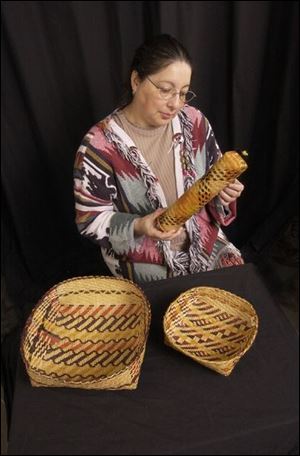
Collection weaves way to museum
3/20/2002
Rhonda Remedies Gauthier of the Choctaw-Apache tribal community from Ebarb, La., examines the baskets from the Malmberg collection on display at the Williamson Museum.
It started with a woven handbag carried by Margie Malmberg more than 30 years ago in Orange, Texas, and ended recently with a donation by her and her husband of more than 100 significant baskets to a university museum in Louisiana.
“The collection is excellent,'' according to Hiram Gregory, an anthropology professor at Northwestern State University in Natchitoches.
Dr. Gregory said one of the most valuable parts of the collection is the cataloguing accomplished by Harold Malmberg and his wife.
It started years ago, Mr. Malmberg said, when one of his wife's friends in Texas noticed the woven bag and said something like, “Let's go find some baskets.
“Margie bought some,'' he said, and it led to the collection that at one time included more than 200 baskets made by craftsmen.
“We put on more than 500,000 miles on three cars, and we didn't miss many states,'' Mr. Malmberg said.
In addition to traveling the country, he added, the couple went into the interior of Australia looking for interesting baskets.
Mr. Malmberg said they collected baskets that appealed to them, but gradually became acquainted with certain basket makers whose work they particularly admired.
“It's Margie's collection,'' he said, although Mr. Malmberg carefully catalogued each purchase. Mrs. Malmberg, however, is ill and could not talk about the collection with The Blade.
“Collecting was her hobby and mine was video,'' he said, snapping a cassette into the television in their comfortable West Toledo condominium and watching a springtime scene of a small house in rural Tennessee.
The next scene is one of seemingly hundreds of baskets in the basement where they were crafted. Mr. Malmberg said that some of those baskets carried price tags as high as $1,000.
After they both retired in the mid-70s. “We traveled a lot and were interested in different things, but Margie was always looking for baskets.
“She became something of an expert.''
Mr. Malmberg, 88, said the collection included photographs and documentation of each purchase. There are also videotapes of purchases and of basket-makers using different techniques.
Eventually, Mr. Malmberg said, “We had about 200 baskets in our condo and it was getting crowded. I was at the end of the line giving baskets to relatives,” he said.
He had become familiar with Dr. Gregory through a Louisiana basket-maker and knew the museum had a collection of baskets and similar artifacts. The couple decided it was the appropriate place for their collection.
Dr. Gregory said the Williamson Museum at the university where the collection is now housed is working toward estimating a value for the baskets.
He said the quality of the baskets is high, but that the cataloguing and taping of the procedures used in making the baskets is also important.
The museum is near the borders of Texas and Oklahoma and is a state and federal repository for archaeological collections for the region. He said the museum is often visited by Native American basket-makers who are trying to learn techniques that have been lost.
“They may remember that an older person once could create a particular pattern and they come here to study the baskets to try to find how it was done,” he said.
Dr. Gregory said that's why the videotapes are an important part of the donation by the Malmbergs.